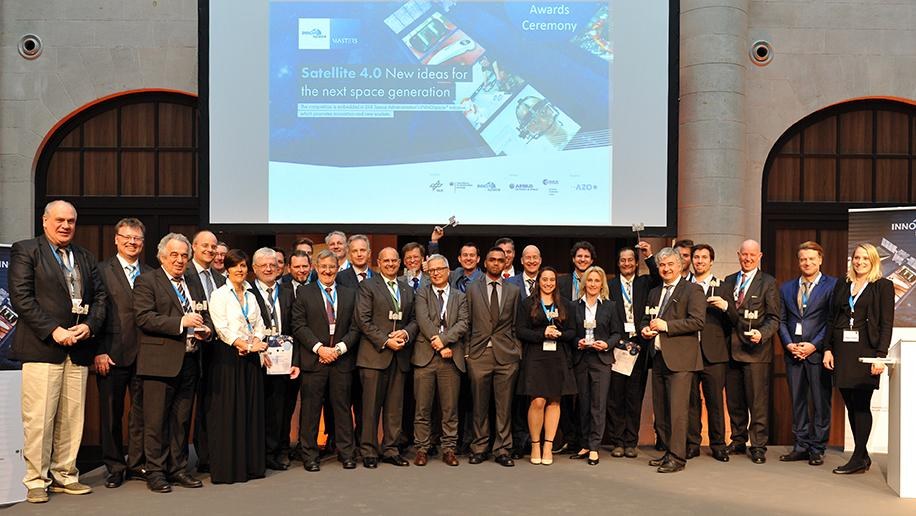INNOspace Masters 2016 competition – winners impress with new ideas for the future of space


A new wireless satellite, innovative laser communication technology for space, a universal adapter for spaceflight – these are just some of the winning entries in the first INNOspace Masterscompetition run by the German Aerospace Center (Deutsches Zentrum für Luft- und Raumfahrt; DLR) Space Administration. Using the slogan ‘Satellite 4.0’, the ideas competition called for the development of new proposals and concepts for the future of space (New Space Economy). Fifty companies, start-ups, universities and research institutions from eight European countries responded to the call. A total of nine finalists from three competition categories impressed the jury with their ideas. The awards ceremony took place at the INNOspace Masters Conference in Berlin on 4 May 2016.
“The INNOspace Masters is an excellent opportunity for companies and research institutions from non-space industries to present their innovations to the space industry,” said Brigitte Zypries, Parliamentary State Secretary at the German Federal Ministry for Economic Affairs and Energy, speaking in her capacity as the Federal Government’s aerospace coordinator.
Three competition categories spanning various space mission development and manufacturing phases were available to applicants. The ‘DLR Space Administration Challenge’ focused on the research and development phase; the ‘Airbus Defence and Space Challenge’ looked for proposals for ready-for-use solutions; and the ‘ESA BIC Start-up Challenge’ was directed at the start-up phase, where market-ready prototypes are being produced. Important topics included flexible platform concepts, intelligent components and cyber-physical systems for complex production and logistics processes.
“The creativity and quality of the competition entries submitted was impressive. New methods in systems development and manufacturing, such as those being used in the aviation and automotive industries, can represent a considerable added value for the development of future satellite systems,” said Gerd Gruppe, the Member of the DLR Executive Board responsible for the DLR Space Administration.
Skith – the world’s first wireless satellite
Overall victory in the competition and first place in the category ‘DLR Space Administration Challenge’ went to Sergio Montenegro and Tobias Mikschl from the Computer Science Department at the Julius Maximilian University of Würzburg. With their Skith project, they developed the world’s first wireless satellite. Until now, all of the individual components of a spacecraft had to be connected to one another via electrical cables. This has changed with Skith. Instead of cables, miniaturised high-speed, real-time radio modules with short ranges are used. This reduces design effort and costs while increasing the satellite’s reliability and flexibility.
Enrico Stoll from the Institute of Space Systems at the Technical University of Braunschweig, Stefan Linke from INVENT GmbH and Andreas Dietz from the Fraunhofer Institute for Surface Engineering and Thin Films took second place with OCULUS. In the OCULUS project, various new production processes are being combined to create carbon structures with highly reflective coatings. In this way, lightweight optical mirrors for use in space can be produced. Third place went to Dirk Mayer and Rogério Salloum from the Fraunhofer Institute for Structural Durability and System Reliability LBF together with Athanasios Dafnis and Andreas Dück from RWTH Aachen University with their proposal for multi-functional lightweight structures for satellites
New laser communication technologies for low Earth orbit
The winner of the ‘Airbus Defence and Space Challenge’ category, Markus Knapek, CEO of ViaLight Communications GmbH, has been working on laser communications for future constellations of satellites in low Earth orbit (LEO). ViaLight develops laser terminals for future LEO constellations and Earth observation missions. These transmit at extremely high data rates of up to 10 gigabits per second over a distance of thousands of kilometres. Second place went to Sandor Woldendorp of Airborne Aerospace B.V. with an entry concerning the development of low-cost satellite designs. Antonio Valente from PLY Technologies GmbH took third place with the OSS4SPACE (Open Sandwich Structures for Space) project, under which the structures of satellite panels are to be optimised.
Universal adapter for space
In the ‘ESA BIC Start-up Challenge’, Giulia Federico, Ran Qedar and Saish Sridharan, founders of Space Products and Innovation UG, came first with their new MA61C multi-purpose adapter. The universal adapter will in future enable computers on board satellites to be connected to their respective subsystems without the need for programming. As a result, both the time and costs involved in manufacturing satellites can be reduced. Two project ideas came in joint second place. One was an idea for developing satellites as cyber-physical systems, from Tuomas Tikka and Nemanja Jovanovic of start-up company Reaktor Space Lab Oy. The other was MPBUS, a modular power bus for spacecraft, submitted by Eduardo Remírez from JMP ingenieros SL.
The organiser of INNOspace Masters is the DLR Space Administration, acting on behalf of the German Federal Ministry for Economic Affairs and Energy (Bundesministerium für Wirtschaft und Energie; BMWi). The competition is part of the DLR INNOSpace Initiative, which has been promoting innovation and technology transfer between space and non-space industry sectors since 2013. Partners in the competition are the ESA Business Incubation Centres (BIC) in Bavaria and Darmstadt and aerospace group Airbus Defence and Space. INNOspace Masters is organised by Anwendungszentrum GmbH Oberpfaffenhofen (AZO), which has also organised the Copernicus Masters and the European Satellite Navigation Competition (ESNC).
